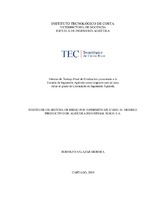Mostrar el registro sencillo del ítem
Diseño de un sistema de riego por aspersión aplicado al modelo productivo de Agrícola Industrial Sukia S.A.
| dc.contributor.advisor | Villalobos-Araya, Marvin | es |
| dc.contributor.author | Salazar-Morera, Rodolfo | |
| dc.date.accessioned | 2020-03-27T14:47:51Z | |
| dc.date.available | 2020-03-27T14:47:51Z | |
| dc.date.issued | 2019 | |
| dc.identifier.uri | https://hdl.handle.net/2238/11285 | |
| dc.description | Proyecto de Graduación (Licenciatura en Ingeniería Agrícola) Instituto Tecnológico de Costa Rica, Escuela de Ingeniería Agrícola, 2019. | es |
| dc.description.abstract | El diseño del sistema de riego se llevó a cabo en la Finca Agrícola Industrial Sukia S.A., ubicada en la Vega de San Carlos, provincia de Alajuela, Costa Rica. Inscrita en el Registro Público y el Registro Mercantil bajo la cédula de Personería Jurídica 3-101-601864, la cual cuenta con 78,8 hectáreas. La finca se comporta de manera integral con dos sistemas de producción. El sistema de producción agrícola se enfoca en tres cultivos: plátano, papaya y pipas los cuales han tenido un comportamiento irregular en cuanto a cosecha, debido al déficit hídrico que ocurre en los meses de febrero, marzo y abril. Las oportunidades que justifican la implementación del sistema de riego con fertirriego se fundamenta en aprovechar la época seca para mantener constante la producción requerida por los clientes a lo largo del año y aumentar el rendimiento del cultivo mediante la tecnificación de la fertilización por medio del sistema de riego. Con los datos recopilados del suelo, topografía y de clima se obtuvo el balance hídrico por medio del modelo Thorntwaite, con el cual se diseñó el sistema de riego que debe aportar para los cultivos en la época más crítica 2,27 milímetros de agua por día. Además se calculó los consumos de nutrientes para el cultivo papaya y plátano donde se llegó a una dosis y el cronograma de aplicación. Mediante un análisis económico se concluye la viabilidad del proyecto con una tasa interna de retorno (TIR) muy favorable de 51% de la inversión. | es |
| dc.description.abstract | The design of the irrigation system was carried out in the Agricultural Industrial Farm Sukia S.A. located in Vega de San Carlos, province of Alajuela, Costa Rica. Registered in the Public Registry and the Commercial Registry under the Identity Card 3-101-601864, which has 78.8 hectares. The farm behaves integrally with two production systems. The agricultural production system focuses on three crops: banana, papaya and pipas which have had an irregular behavior in terms of harvest, due to the water deficit that occurs in the months of February, March and April. The opportunities that justify the implementation of the irrigation system with fertigation are based on taking advantage of the dry season to maintain constant production required by customers throughout the year and increase crop yield through the technification of fertilization through the system of irrigation. With the collected data of the soil, topography and climate the water balance was obtained by means of the Thorntwaite model, with which the irrigation system was designed that must provide for crops in the most critical period 2.27 millimeters of water per day . In addition, the consumption of nutrients for the papaya and plantain crops where a dose was reached and the application schedule was calculated. Through an economic analysis, the viability of the project is concluded with a very favorable internal rate of return (IRR) of 51% of the investment. | es |
| dc.language.iso | spa | es |
| dc.publisher | Instituto Tecnológico de Costa Rica | es |
| dc.rights | acceso abierto | es |
| dc.subject | Diseño de sistema de riego | es |
| dc.subject | Riego por aspersión | es |
| dc.subject | Sistemas de producción | es |
| dc.subject | Producción agrícola | es |
| dc.subject | Irrigation system design | es |
| dc.subject | Sprinkler irrigation | es |
| dc.subject | Production systems | es |
| dc.subject | Agricultural production | es |
| dc.subject | Research Subject Categories::FORESTRY, AGRICULTURAL SCIENCES and LANDSCAPE PLANNING::Area technology::Agricultural engineering | es |
| dc.title | Diseño de un sistema de riego por aspersión aplicado al modelo productivo de Agrícola Industrial Sukia S.A. | es |
| dc.type | proyecto fin de carrera | es |


